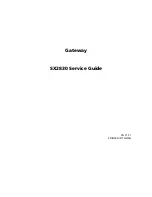
2
Management
35
Time servers
The
hardware
clock
that
the
SEG
uses
can
sometimes
become
fast
or
slow
after
a
period
of
operation.
This
is
normal
behavior
in
most
network
and
computer
equipment
and
is
solved
by
using
Time
Servers
.
The
SEG
is
able
to
adjust
the
clock
automatically
based
on
information
received
from
one
or
more
time
servers
which
provide
a
highly
accurate
time,
usually
using
atomic
clocks.
Using
time
servers
is
highly
recommended
as
it
ensures
the
SEG
will
have
its
date
and
time
aligned
with
other
network
devices.
For
hardware
platforms
without
battery
backup
of
the
system
clock,
using
time
servers
is
a
useful
way
to
automatically
set
the
correct
time
after
initial
startup.
SNTP protocol
Time
Synchronization
Protocols
are
standardized
methods
for
retrieving
time
information
from
external
time
servers.The
SEG
supports
the
Simple
Network
Time
Protocol
(SNTP)
as
defined
by
RFC
5905
(SNTPv4).
Configuring time servers
More
than
one
time
server
can
be
configured
to
query
for
time
information.
Using
more
than
a
single
server
prevents
the
time
synchronization
process
from
failing
due
to
an
unreachable
server.
The
SEG
always
queries
all
configured
servers
and
then
computes
an
average
time
based
on
all
responses.
To
configure
servers,
the
steps
are:
1. Set
the
TimeSyncEnable
option
on
the
DateTime
object
to
Yes.
2. Add
each
configured
server
as
a
new
TimeServer
object
to
the
DateTime
object.
Example: Enabling time synchronization using SNTP
In
this
example,
time
synchronization
will
be
enabled
and
two
time
servers
will
be
configured
with
IPv4
addresses
10.5.4.36
and
10.5.4.76
.
The
created
TimeServer
objects
will
be
given
the
names
my_tsrv1
and
my_tsrv2
.
1. Change
the
context
to
be
DateTime
:
Device:/>
cc
DateTime
2. Add
a
TimeServer
object
with
the
name
my_tsrv1
:
Device:/DateTime>
add
TimeServer
IP=10.5.4.36
Name=my_tsrv1
3. Add
the
second
server:
Device:/DateTime>
add
TimeServer
IP=10.5.4.76
Name=my_tsrv2
4. Return
to
the
default
root
context:
Device:/DateTime>
cc
5. Activate
and
commit
the
configuration
changes.
















































